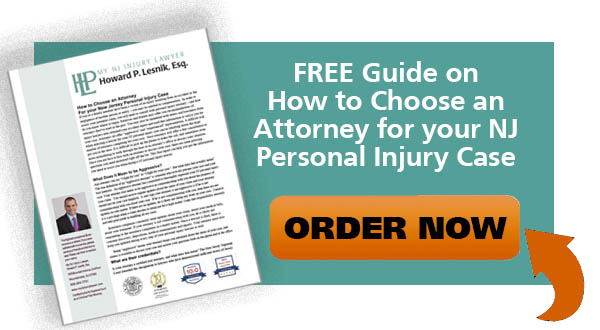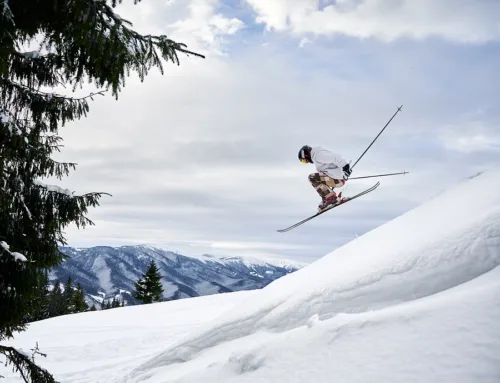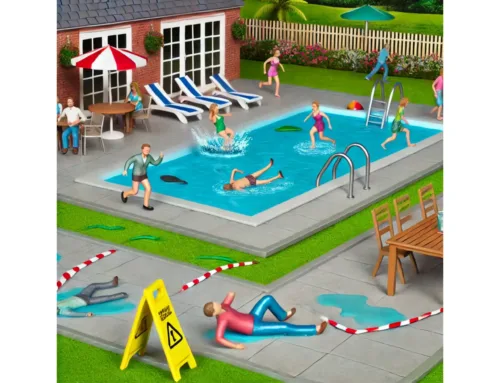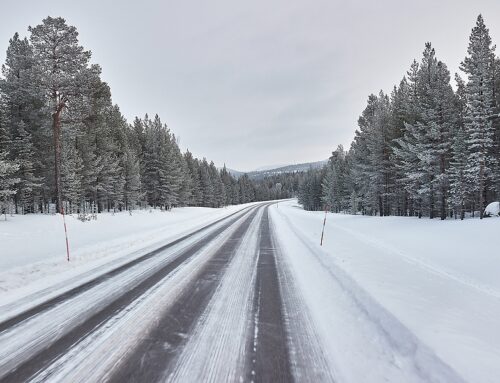In the immediate aftermath of a snowstorm, the bitter cold and piles of snow and ice make venturing outside a frightening event. Winter storms can leave behind dangerously slippery conditions for anyone traveling on foot, even if just walking to their car. However, when the temperature starts to rise a little, surely that’s a sign of safer walking conditions to come, right? Not always. Warmer days and freezing nights result in freeze and thaw cycles that actually make it more dangerous to travel on sidewalks, driveways, and even parking lots.
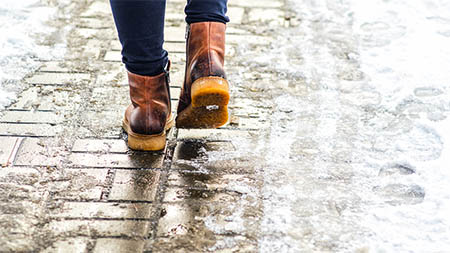 It may seem illogical that warmer temperatures can actually increase your risk of slipping and falling on ice, but this happens because the cold air can’t hold as much moisture as warmer air. Even when it gets warm enough for ice and snow to begin melting, the air is still very cold, and little of that melted ice can evaporate. The liquid pools on the surface of the still-frozen ice, reducing what little traction exists between the ice and an unlucky pedestrian’s boots. Worse still, if there are any uneven or roughened patches of ice, those rough patches are the first to melt away, leaving only the smoothest and most slippery ice intact. When night falls and temperatures drop again, the melted water refreezes as flat and smooth as the surface of a lake, creating increasingly dangerous conditions for anyone who has to walk across it the next morning.
It may seem illogical that warmer temperatures can actually increase your risk of slipping and falling on ice, but this happens because the cold air can’t hold as much moisture as warmer air. Even when it gets warm enough for ice and snow to begin melting, the air is still very cold, and little of that melted ice can evaporate. The liquid pools on the surface of the still-frozen ice, reducing what little traction exists between the ice and an unlucky pedestrian’s boots. Worse still, if there are any uneven or roughened patches of ice, those rough patches are the first to melt away, leaving only the smoothest and most slippery ice intact. When night falls and temperatures drop again, the melted water refreezes as flat and smooth as the surface of a lake, creating increasingly dangerous conditions for anyone who has to walk across it the next morning.
In the best case, a slip and fall on ice may result in little worse than some embarrassment and snow-soaked trousers. Very often, however, the outcome of a slip and fall accident is much worse. Concussion injuries (referred to in the medical profession as TBIs, or traumatic brain injuries), serious sprains, and fractured bones are some of the most common injuries sustained in a fall on ice. If your hands are full when you slip and begin to fall, you may find yourself unable to recover your balance or catch yourself to break your fall, increasing your chances of sustaining serious injury. Many slip and fall injuries require hospital visits, physical therapy, and even surgery in order for the injury victim to reach maximum recovery potential. In some cases the victim is left with a lasting injury that causes chronic pain, limits mobility, or renders them unable to return to their job, hobbies or other daily activities. If your injury was caused by another party’s negligent failure to maintain a safe walkway on their property, it’s imperative that you know what rights you have to seek compensation for your injuries.
The duty of care imposed on a property owner depends in part on the type of property in question. Because businesses rely on customers visiting their property in order to earn a profit, business owners and commercial property managers have a greater responsibility to ensure that prospective customers have a safe pathway to enter, exit, and move through their property. Residential property owners do not have a similar responsibility and are not held responsible, generally, for naturally occurring accumulations of ice and snow, under some limited circumstances can be held accountable for such conditions – an experienced personal injury attorney will be able to tell you.
The weather conditions at the time of the slip and fall accident also factor into the question of liability. While no reasonable person expects perfectly clear sidewalks and stairs in the middle of a blizzard, freeze and thaw cycles are predictable conditions that take place during clearer weather, making the danger of slipping hazards readily foreseeable and providing property owners with ample opportunity to take appropriate steps to mitigate that danger.
In addition to the responsibility that property owners have to provide safe walkways, pedestrians also have a legal duty of care to take reasonable precautions for their own safety. Lawyers working for a property owner’s insurance company will be quick to jump on this point, challenging whether you took appropriate care to avoid slipping and getting hurt. Trying to place part of the blame for an accident on the injury victim is a common defense tactic. This is an example of the legal principle of comparative fault. If an injured plaintiff in New Jersey is determined to be partially responsible for the accident that caused their injuries, the amount of damages they are able to collect for their injuries is reduced in proportion to the amount of fault they are determined to bear for the accident. Thus, an injured plaintiff who was deemed to bear 20 percent of the fault for an accident could collect 80 percent of the total value of her injury damages. This is why it’s so critical to work with an experienced injury attorney who can gather and preserve evidence from your accident.
This is why it is important to consult with an experienced personal injury lawyer. An experienced lawyer will attempt to gather photographs and video evidence of your fall. An attorney will attempt to locate witnesses who witnessed the fall or the dangerous ice and snow condition that caused your injuries. An attorney may also retain an expert to review the facts of your slip and fall and the negligence of the party that is responsible for your slip and fall.
Contact MyNJInjuryLawyer
If you or a loved one is injured in a slip and fall accident in NJ, you should contact an attorney familiar with handling these claims. An experienced NJ Injury Lawyer will know how to obtain the incident report, preserve the security video of your fall, and contact the insurance company for the property owner so you can make a claim for your injuries.
My NJ Injury Lawyer Howard P. Lesnik, Esq. offers free strategy sessions to address any issue or questions you may have your apartment complex slip and fall claim in NJ.
Please contact NJ Injury Lawyer Howard Lesnik, Esq., immediately if you were involved in a slip and fall accident. I personally handle NJ personal injury cases on a regular basis. Please contact me now by email, by phoning 908.264.7701, or by completing the form to the right to schedule your complimentary 30-minute strategy session.


